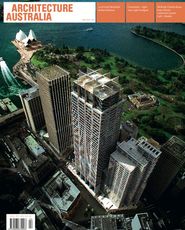How do we, as architects, engage critically with the contemporary world? Richard Francis-Jones discusses plans for Critical Visions: Form, Representation and the Culture of Globalisation, this year’s RAIA conference.
What is the objective of this conference? What do you hope to achieve?
We are trying to create an event that could be described as a “critical forum”. It will be an opportunity to set aside, for three days, the intensity of practice, the demanding pressures of our industry, our studies, research or teaching, and collectively to explore and debate responses to some of the most pressing issues that confront contemporary architecture.
It is to be a forum for debate, provocation, questioning and illumination. To achieve this, it is important to have a varied and stimulating structure. We will have many different types of sessions: keynote presentations of work and ideas, comparative panel presentations, discussions and debates, and the actual presentation and jury critique of propositions specifically prepared for the conference in a studio-like environment. I am hoping it will be a very provocative, exciting and inspiring few days.
Can you explain your thinking behind the theme?
The intensity of contemporary global architectural production and urbanization is extreme and without precedent. The seemingly endless formal inventiveness and expressive possibilities of architecture are reaching new dimensions, along with the technology, the will and the capital needed to realize such spectacular expressions, particularly in the fast-growing or oil-rich centres of the globe. And yet these exciting expressions of apparent optimism and faith in economic growth are taking place at a time of distressing social inequality, cultural conflict and impending environmental crises.
How can architecture respond to the critical environmental and social challenges of this moment, which also seems to hold unprecedented opportunity and inventive promise? What future visions and alternatives are we offering? How is the architectural project to respond to this time of simultaneous global crisis and indulgence? Possible responses to these questions underpin the central theme of the conference. At this time of great challenge and opportunity within our increasingly globalized culture, what critical visions can we offer?
What is your thinking behind the selection and number of speakers involved?
To explore these issues in any depth it is important to have a diversity of visions. We need to provide the opportunity to see how architects and academics are responding to these challenges in different contexts and at different scales. So we have speakers from Europe, America, Asia and Australia who are working at vastly different scales and in different forms of practice and research, each of whom carefully defines a possible critical vision of architecture. We have also expanded the main conference to a third day to ensure we have the opportunity for thorough debate. Importantly, speakers include not only many international and Australian architects and academics, but also emerging practitioners and students.
You suggest using Sydney as a kind of urban laboratory. What do you mean by this?
The conference will include a series of sessions that explore polemical visions for possible urban futures. We intend to use Sydney, both the centre and the expanding suburban region, as a kind of “urban laboratory” to explore possible future responses to the critical issues and challenges that confront us. A select group of emerging architectural teams have been invited to prepare future visions for Sydney. These will be presented and critically reviewed by a distinguished jury panel at the conference in the “Studio”, a flat-floor venue that will complement the auditorium, and which is more conducive to this form of critique and discussion.
It is also vital to have different modes of discussion and presentation and, naturally, this requires different types of venue. A great deal of discussion at conferences is informal and takes place in the foyers and bars. So we have created an informal default evening venue in the city (CV-Bar), where people can go for a drink, meet and have more vigorous discussion with other delegates and speakers at the end of each conference day.
Richard Francis-Jones is Creative Director of Critical Visions, the 2008 RAIA Conference, to be held in Sydney 10–12 April, and a director of Francis-Jones Morehen Thorp.















